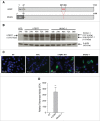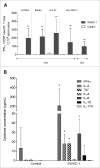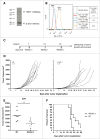Anticancer DNA vaccine based on human telomerase reverse transcriptase generates a strong and specific T cell immune response
- PMID: 27141336
- PMCID: PMC4839321
- DOI: 10.1080/2162402X.2015.1083670
Anticancer DNA vaccine based on human telomerase reverse transcriptase generates a strong and specific T cell immune response
Abstract
Human telomerase reverse transcriptase (hTERT) is overexpressed in more than 85% of human cancers regardless of their cellular origin. As immunological tolerance to hTERT can be overcome not only spontaneously but also by vaccination, it represents a relevant universal tumor associated antigen (TAA). Indeed, hTERT specific cytotoxic T lymphocyte (CTL) precursors are present within the peripheral T-cell repertoire. Consequently, hTERT vaccine represents an attractive candidate for antitumor immunotherapy. Here, an optimized DNA plasmid encoding an inactivated form of hTERT, named INVAC-1, was designed in order to trigger cellular immunity against tumors. Intradermal injection of INVAC-1 followed by electrogene transfer (EGT) in a variety of mouse models elicited broad hTERT specific cellular immune responses including high CD4+ Th1 effector and memory CD8+ T‑cells. Furthermore, therapeutic INVAC‑1 immunization in a HLA-A2 spontaneous and aggressive mouse sarcoma model slows tumor growth and increases survival rate of 50% of tumor-bearing mice. These results emphasize that INVAC-1 based immunotherapy represents a relevant cancer vaccine candidate.
Keywords: Cancer; DNA vaccines; electrogene transfer; electroporation; hTERT; immunotherapy.
Figures





Similar articles
-
Enhanced antitumor effect against human telomerase reverse transcriptase (hTERT) by vaccination with chemotactic-hTERT gene-modified tumor cell and the combination with anti-4-1BB monoclonal antibodies.Int J Cancer. 2006 Oct 15;119(8):1886-96. doi: 10.1002/ijc.22048. Int J Cancer. 2006. PMID: 16708388
-
Highly optimized DNA vaccine targeting human telomerase reverse transcriptase stimulates potent antitumor immunity.Cancer Immunol Res. 2013 Sep;1(3):179-189. doi: 10.1158/2326-6066.CIR-13-0001. Epub 2013 Jul 17. Cancer Immunol Res. 2013. PMID: 24777680 Free PMC article.
-
A First-in-Human Phase I Study of INVAC-1, an Optimized Human Telomerase DNA Vaccine in Patients with Advanced Solid Tumors.Clin Cancer Res. 2020 Feb 1;26(3):588-597. doi: 10.1158/1078-0432.CCR-19-1614. Epub 2019 Sep 26. Clin Cancer Res. 2020. PMID: 31558479
-
Telomerase in cancer immunotherapy.Biochim Biophys Acta. 2010 Jan;1805(1):35-42. doi: 10.1016/j.bbcan.2009.09.001. Epub 2009 Sep 12. Biochim Biophys Acta. 2010. PMID: 19751801 Review.
-
Telomerase as a universal tumor antigen for cancer vaccines.Expert Rev Vaccines. 2008 Sep;7(7):881-7. doi: 10.1586/14760584.7.7.881. Expert Rev Vaccines. 2008. PMID: 18767939 Review.
Cited by
-
Telomerase and CD4 T Cell Immunity in Cancer.Cancers (Basel). 2020 Jun 25;12(6):1687. doi: 10.3390/cancers12061687. Cancers (Basel). 2020. PMID: 32630460 Free PMC article. Review.
-
Trial watch: DNA-based vaccines for oncological indications.Oncoimmunology. 2017 Nov 20;6(12):e1398878. doi: 10.1080/2162402X.2017.1398878. eCollection 2017. Oncoimmunology. 2017. PMID: 29209575 Free PMC article. Review.
-
Clinical research progress of telomerase targeted cancer immunotherapy: a literature review.Transl Cancer Res. 2024 Jul 31;13(7):3904-3921. doi: 10.21037/tcr-24-196. Epub 2024 Jul 17. Transl Cancer Res. 2024. PMID: 39145070 Free PMC article. Review.
-
Telomerase in Cancer: Function, Regulation, and Clinical Translation.Cancers (Basel). 2022 Feb 5;14(3):808. doi: 10.3390/cancers14030808. Cancers (Basel). 2022. PMID: 35159075 Free PMC article. Review.
-
A DNA telomerase vaccine for canine cancer immunotherapy.Oncotarget. 2019 May 21;10(36):3361-3372. doi: 10.18632/oncotarget.26927. eCollection 2019 May 21. Oncotarget. 2019. PMID: 31164958 Free PMC article.
References
-
- Novellino L, Castelli C, Parmiani G. A listing of human tumor antigens recognized by T cells: march 2004 update. Cancer Immunol Immunother 2005; 54:187-207; PMID:15309328; http://dx.doi.org/10.1007/s00262-004-0560-6 - DOI - PMC - PubMed
-
- Collins K, Mitchell JR. Telomerase in the human organism. Oncogene 2002; 21:564-79; PMID:11850781; http://dx.doi.org/10.1038/sj.onc.1205083 - DOI - PubMed
-
- Hanahan D, Weinberg RA. Hallmarks of cancer: the next generation. Cell 2011; 144:646-74; PMID:21376230; http://dx.doi.org/10.1016/j.cell.2011.02.013 - DOI - PubMed
-
- Shay JW, Bacchetti S. A survey of telomerase activity in human cancer. Euro J Cancer 1997; 33:787-91; PMID:9282118; http://dx.doi.org/10.1016/S0959-8049(97)00062-2 - DOI - PubMed
-
- Zhu CQ, Cutz JC, Liu N, Lau D, Shepherd FA, Squire JA, Tsao MS. Amplification of telomerase (hTERT) gene is a poor prognostic marker in non-small-cell lung cancer. Brit J Cancer 2006; 94:1452-9; PMID:16641908; http://dx.doi.org/10.1038/sj.bjc.6603110 - DOI - PMC - PubMed
Publication types
LinkOut - more resources
Full Text Sources
Research Materials
